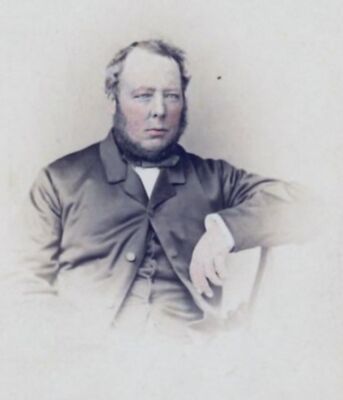John Cameron
Individual, P001
Biography
John Cameron (1806 - 1866), the son of Alexander and Elizabeth Cameron, was born in London and baptised at St Botolph's church, Aldgate. His mother's family were from Brastead in Kent, England. He first arrived in Van Diemen’s Land in 1823, among the earliest free settlers. After a trip to England in 1827, he moved to Launceston in 1829 to set up a drapery business. He again returned to England in 1836 and married Eliza Milburn Snell in London on 25th February 1837. They returned to Launceston where their first child, Emma, was born on 27th January 1838. Following their marriage, the Camerons joined the congregation at St John’s (but John was also involved with establishing a Presbyterian kirk in Launceston in 1831).
As a young man, John established himself as a retail and wholesale merchant in Launceston and had a number of business interests. He had significant holdings in real estate and is credited with establishing Brisbane Street as the principal shopping precinct in Launceston. He was a shareholder in various local enterprises, a founding director of the Launceston Gas Company formed in 1858, a trustee of the Devon Road District and of the Tasmanian Permanent Building and Investment Society. He was appointed a Justice of the Peace in 1845, but declined to seek public office in the local council or government.
John lived above his shops, mostly above what we know as Birchall's building in Brisbane Street. He bought a large house at Newnham (now Newnham Hall) from Matthew Curling Friend in 1837. He undertook major extensions to the house in 1840s and sold it to W.A. Gardner in 1853 when the Camerons left for 4 years in London. When they returned, they lived at the SE corner of St. John and York Street, a property he had bought from Clayton, and opposite three buildings, known as Camerons Buildings on the other side of St John St. John ran his wholesale business from there until another trip to England in 1863. On their return John leased the newly built Oakburn in Patersons Plains Road (now Elphin Rd). He stipulated in a codicil to his will that Eliza should stay there until the end of the lease. He also had two grants of land in the country, ‘Hawkridge’ at Snake Banks (Powranna), and ‘Combe Bank’ near Ben Lomond.
The Cameron family made several journeys back to England, and their youngest child, Kate, was born in London on 4th March 1856. Emma, the eldest, married Robert Walker, who became Mayor of Hobart.
John was a strong supporter of St. John’s Church and was a churchwarden there in 1839 and 1840, becoming heavily involved in the life of the church. In April that year, John was present at a meeting of members and friends of the Church of England to form a District Committee of the Societies for the Propagation of the Gospel and for the Promotion of Christian Knowledge. By August John was stocking SPCK publications for sale in his shop, Mr. Cameron’s, and receiving applications for membership.
On his return from an absence of four years (1853-56), John picked up the threads of his previous interests, and was elected by St. John’s parishioners as their lay representative to first meeting of the new diocesan synod in 1857, continuing in the role for the next 2 years. He became involved in diocesan committees dealing with finances, Christ’s College, Launceston Church of England Grammar School and the Hutchins School along with the subcommittee for the Launceston Archdeaconry. He was also elected to a Board of Patronage to fill a vacancy at St John’s, and also for Christ’s Church, Longford the same year, and for Holy Trinity, Launceston in 1859.
A small square chancel was erected at the east end of St. John’s in 1866-68, and Cameron promised a ‘magnificent window’, ordering a three-light stained-glass window from Ferguson & Urie of Melbourne, for the new extension. However, he died before it arrived in Launceston and so Emma Cameron presented the window as his memorial soon after in 1866.
When St. John’s was extended in 1901-1911, the small chancel was removed and its windows stored in the tower. At some point, Cameron’s daughter Kate discovered that the window had been removed and not reinstalled, evidently causing much displeasure, because in 1922, a request was made to the diocese that if the window was not to be used, it should go to Kingston. This was likely the impetus for the window to be temporarily reinstalled in the existing northern window arches of the nave, and it is visible in a photograph of the old nave dating from about 1930.
In 1938, the second stage of the rebuilding of St. John’s took place, with the walls of the nave being raised, and three great three-light windows installed on the north and south sides. The beautiful Cameron window has graced the south clerestory since then. Its subject is ‘The Ascension’, The top part of the window was not repositioned, but the 3 round features (roundels) are in the church archive. The inscription has disappeared.
Source
Linked article by Anne Cameron Batt kindly forwarded to St. John's in 2025.Some earlier content from Engraved in Memory by J.S.Gill. 1988
Related objects
Roundel - Omega (contributor)Roundel - Alpha (contributor)
Roundel - Dove (contributor)
John Cameron Memorial Window (contributor)
Online Sources
https://www.clan-cameron.org.au/genealogy/getperson.php?personID=I81857&tree=cameron1
John Cameron - A biography
https://resources.allsaints.network/documents/History/John_Cameron_biography.pdf
